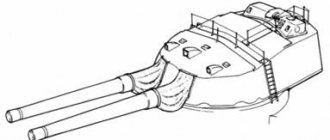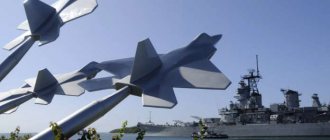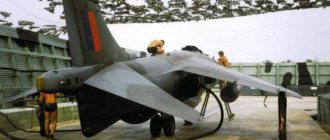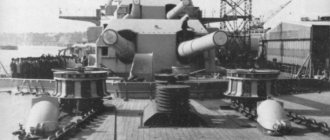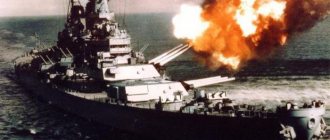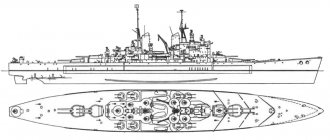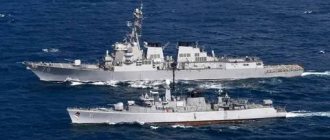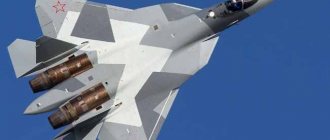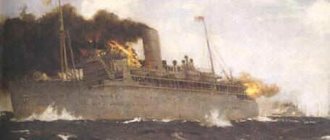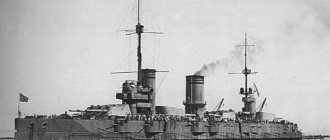HMS R08 is the lead ship in a series of two aircraft carriers for the British Navy. Named after Queen Elizabeth I of England (1558–1603). It is the largest Royal Navy ship in the fleet's history and the largest warship ever built in the country. This aircraft carrier, like its sister ship under construction Prince of Wales, is three times larger than its Invincible-class predecessors and is comparable to the American Nimitz and the French Charles de Gaulle. The core of the Queen air group should be fifth-generation Lockheed Martin F-35B carrier-based fighters.
HMS Queen Elizabeth Photo: © Gareth Fuller/PA via AP
The new aircraft carrier is the second Royal Navy ship to bear the name HMS Queen Elizabeth. Previously, the lead ship in a series of five ironclads built between 1913 and 1916 was named after Queen Elizabeth I. In addition, the 54,500 ton aircraft carrier CVA-01 was developed in the 1960s and was also planned to be named HMS Queen Elizabeth, but the project was cancelled.
What is a battleship?
A battleship (short for “ship of the line”) is a class of armored military ships equipped with heavy artillery guns. The length of these vessels varied from 150 to 280 meters, and their displacement reached 70 tons. Created to destroy and exterminate enemy ships, battleships were direct evolutionary successors of battleships. The progenitor of the battleship class was the English ship Dreadnought, which was born in 1906. The Dreadnought had a steam turbine power plant, which provided it with an enormous speed at that time - 21 knots (converting knots to kilometers, we can say that its speed then reached 39 km/h). The construction of the Dreadnought and the use of its advantages at sea significantly changed the state of affairs in the naval arms race and in the field of shipbuilding in general. So, following the British, one after another, countries began to create battleships with single-caliber guns and modernize them, wanting to overtake their rivals. Ships of this type received the name of their ancestor - “dreadnoughts”, and more improved versions - “superdreadnoughts” and “superdreadnoughts”.
The history of the creation of the Queen Elizabeth series
The next step in the development of global and military shipbuilding was the creation by the British of the Queen Elizabeth class battleships. In this series, five super-dreadnoughts were designed and presented: “Malaya”, “Valiant”, “Barham”, “Warspite” and the lead ship - “Queen Elizabeth”, named, like the series itself, in honor of the English queen, mistress of the seas, Elizabeth I. These ships owe their appearance to Winston Churchill, who, as the First Lord of the Admiralty, with his characteristic passion and ideas, insisted on a different design of these battleships and on their significant modifications, ordering that these ships be equipped with super-heavy combat weapons. According to rumors, the United States, Germany and Japan were already actively improving their ships, several steps ahead of the British Royal Navy. There was no time for thorough testing of weapons, so Sir Winston Churchill had no choice but to take the risk and, taking responsibility, lay down a series of ships without waiting for the guns to be checked and tested. Fortunately, the risk was worth it. On average, the construction of such battleships cost £1,960,000.
vo_vsey_svoey_krase.jpg
Before the advent of supertankers in the 1960s, Queen Elizabeth was not only the largest passenger liner, but also the largest ship in the world fleet. It had 14 decks, of which four: sports, sun, boat and pleasure decks were located in the superstructure. The six upper decks housed all the passenger cabins and most of the public spaces. The decks were connected to each other by 35 elevators.
Passenger accommodations were divided into three classes: first, cabin and tourist. The liner was decorated with works of the best artists and architects. Passengers could admire plaster and bronze sculptures, paintings, excellent wood carvings, mosaics, and tapestries.
When company representatives were asked why they needed to create such luxury on the Queens, they replied that these amounts were an insignificant fraction: some five percent of the construction cost, but it attracted passengers.
But comfort itself does not make travel interesting. It is equally important to be able to entertain passengers who are knocked out of their usual rhythm of life for several days. How is this problem solved on a huge liner, where the passenger sometimes gets lost, feeling like a provincial who finds himself in an unfamiliar capital city?
Let's start with the most restless part of passengers - children. For them, the liner provided children's rooms with beautiful paintings of fairy-tale scenes, a variety of games and toys. There were fairy-tale houses, and real boats, dolls and bears, so that the kids, having entered this magical kingdom, instantly forgot their mothers and fathers, without stopping them from enjoying the journey.
What did the adults do on the Queen Elizabeth? Fans of long walks took the elevator to the sports deck. Eight laps on this deck is already almost 2 km. Twenty-four laps - and the passenger can go to the restaurant, confident that he will not have to complain about the lack of appetite. There were also places for those who like to go for walks in the company of their four-legged friends.
Series features
The battleship Queen Elizabeth and similar ships, as mentioned earlier, differed from their predecessors and had a number of features. First of all, these battleships had guns with a 15-inch caliber - enormous power at that time. Secondly, the super-dreadnoughts of this series became the first large ships to run on oil fuel; previously, battleships of this size were powered only by steam. Thirdly, the speed of the Queen Elizabeth class battleships reached 24 knots (if you convert knots to kilometers per hour, it will be clear that the speed of such ships reached 45 km/h). In addition, these ships had the highest metacentric height in the entire British fleet, this perfectly ensured their stability and helped withstand wave impacts and strong gusts of wind.
Battleship Queen Elizabeth: characteristics and description
The lead ship of the series was laid down at the Portsmouth Navy Yard on October 12, 1912. Built in the shortest possible time, it was launched in October 1913 and was later completed afloat. The outbreak of the First World War also contributed to the accelerated completion of the ship, so it is not surprising that at the beginning of 1915 the battleship already became part of the British Navy.
The length of the battleship Queen Elizabeth is 183.41 m, width is 27.6 m, standard displacement is 29,200 tons. The armor of this ship is almost identical to its predecessor, the Iron Duke, with the exception of some elements, for example, the layer of metal armor along the waterline was increased, and along the main deck, on the contrary, weakened. The superdreadnought's armament: 8 naval guns (381 mm), 16 anti-mine installations (152 mm), 2 anti-aircraft guns (76 mm), 4 underwater single-tube torpedo tubes (533 mm). Queen Elizabeth used Parsons turbines and 24 boilers. Thus, the power of this battleship reached 75,000 horsepower.
Queen's capabilities
The aircraft carrier has at least three launchers of the Phalanx CIWS naval anti-aircraft artillery system, 30 mm artillery mounts, as well as various types of machine guns.
Let us quote the words of TASS military observer, Viktor Litovkin: “The Queen has practically no weapons, but the Russian aircraft carrier Admiral Kuznetsov has a powerful set: the Granit anti-ship missile system, the Korotik and Kinzhal anti-aircraft missiles... This is explained the fact that British aircraft carriers, like American ones, are part of a carrier strike group, where they have a powerful retinue of cruisers, frigates and corvettes that protect them from attack from the air, from the sea and from under water. And our heavy cruiser is capable of solving such problems independently.”
The Queen's total displacement is 70,600 tons, its crew is 679 people, and its air group is about 900 people.
- Length - 280 m, height - 56 m, draft - 11 m;
- Maximum width - 73 m;
- The hangar dimensions are 155 x 33.5 x 6.7 m, it can accommodate up to 20 aircraft and helicopters;
- Maximum speed - 26 knots (about 48 km/h);
- Cruising range at a speed of 15 knots is 10 thousand nautical miles (about 18,500 km);
- Autonomy - 290 days.
The ship has two superstructures - bow and stern, in which long- and medium-range radar stations developed by BAE Systems and Thales are mounted. The flight deck is equipped with a bow ramp for take-off of carrier-based aircraft, two aircraft receivers, and 56 lifts for supplying ammunition.
HMS Queen Elizabeth Photo: © EPA/GERRY PENNY
The main power plant includes:
- two Trent MT30 gas turbines with a capacity of 36 MW (49 thousand horsepower) each, manufactured by the British company Rolls-Royce;
- four Wartsila 38 diesel generators made in Finland with a capacity of 11 MW (15 thousand horsepower) each;
- four asynchronous electric motors with a power of 20 MW (27 thousand horsepower) each to drive two lines of shafts and propellers.
The aircraft carrier is equipped with an automated combat control system integrated with long-range radar, which allows it to track up to 1 thousand air targets at a distance of 250 nautical miles (about 460 km). The ship also has a special center for the commander of a carrier strike group (ACG).
“British and American AUGs are designed to conduct expeditionary operations and intimidate “rebellious” states, as US aircraft carriers do today off the coast of the DPRK. Our aircraft carrier is designed to protect a group of its ships in the operational deployment zone and protect strategic trade routes, including to support ground forces in the fight against terrorists, which Kuznetsov aircraft did during the fight against IS militants in Syria.” Viktor Litovkin, military observer for TASS.
In 2016, a Russian aircraft carrier, during a voyage to the Mediterranean Sea, took part for the first time in the operation of the Russian Aerospace Forces in Syria. Then the Kuznetsov deck pilots carried out 420 combat missions (117 at night), and more than a thousand terrorist targets were destroyed.
The Queen Elizabeth air group can include up to 40 aircraft, including up to 24 Lockheed Martin F-35B fighters, helicopters of various types, including the AgustaWestland AW101 Merlin HM2.
F-35B Lightning II fighter Photo: © Natasha R. Chalk/US Navy via Getty Images
Carrier-based testing of the F-35B is expected to begin in late 2022. During the same period, it is planned to adapt the aircraft carrier to accommodate army aviation helicopters - AH-64 Apache, CH-47 Chinook, AW159 Wildcat of various modifications. These activities will be carried out as the Ministry of Defense is considering the possibility of using the aircraft carrier in joint interservice and littoral operations.
According to Paul Rafferty, director of project management for the group of companies building aircraft carriers ACA, tests of British F-35B fighters for the Queen Elizabeth aircraft carrier will be carried out in the United States. “In the first quarter of 2022, aircraft testing will begin on the east coast of the United States. The F-35s have already conducted two comprehensive aircraft tests aboard the American amphibious assault ship USS Wasp, LHD-1,” he said.
According to plans, the ship and air group will reach initial combat readiness in 2022, and full combat readiness in 2023.
For comparison, the only Russian aircraft carrier, Admiral Kuznetsov, carries on board up to 30 MiG-29K/KUB and Su-33 fighters, as well as Ka-52K attack helicopters and Ka-27 and Ka-29 anti-submarine helicopters.
The further fate of the battleship
In 1915, the battleship Queen Elizabeth was sent to the Dardanelles to support the landings during the Battle of Gallipoli; during this mission, the British battleship sank a Turkish transport in the shallow Nagara Bay with fire from the third salvo. Despite her high speed and super-heavy guns, the lead ship was unable to participate in the largest battle of the First World War - the Battle of Jutland, but in 1917 she became the flagship of Admiral David Beatty, commander of the Grand Fleet.
The Second World War found the battleship Queen Elizabeth at the time of modernization. Until 1941, the Queen Elizabeth served as part of the British Home Fleet. But in December of the forty-first year, while parked in Alexandria, the battleship was seriously damaged by Italian combat swimmers using magnetic mines, which led to the formation of a large hole and the flooding of many compartments. After repairs, the battleship was sent to the Indian Ocean and from the beginning of 1944 became the flagship of the Eastern Fleet, making several raids on the islands of Indonesia and Malaysia. In July 1945, the battleship Queen Elizabeth made her last military campaign, went into reserve in August of the same year and was sold for scrap a couple of years after that.
Britain's first aircraft carriers
Along with the USA, England was among the first countries to conduct many tests before creating ships with aircraft on board. Initially, the ships were rebuilt from linear transport ships - the deck surface was increased and strengthened to be able to accommodate weapons on it. In the early years of the 20th century, the Navy commissioned its first seaplane carriers. They housed seaplanes that took off and landed directly from the water surface. And with the help of a special crane, the weapons were lowered into the water and lifted onto the ship. Among the first such ships were HMS Ark Royal and HMS Ben-my-Chree. Both ships took an active part in the First World War. Such developments showed the possibility of conducting combat operations from the air far from home. However, they had a significant drawback. When the sea was very rough, it was not possible to continue combat missions using hydroaviation.
HMS Ark Royal 1914 model
Aircraft carrier HMS Furious
The development of the American fleet required new developments and the Royal Navy. Thus, the first British aircraft carrier Furies was converted from a light battle cruiser. Its deck was increased and was 50 meters. However, this distance was not enough for a safe landing of the plane and it had to be landed on the water. Only one landing was successful - pilot Edwin Harris Dunning equalized the speed of the plane with the speed of the ship, after which the sailors manually pulled the ship on board, as if hanging in the air. 5 days later, a second similar attempt ended tragically: the plane overturned and the pilot died.
HMS Furious 1918
The failure that occurred required further modernization. The deck was increased to 100 meters, and catching nets and arresting devices were installed. During a combat mission on August 19, 1918, seven aircraft that took off from Furies successfully completed their task - they bombed German hangars with airships. At the same time, not a single pilot was able to land the ship on board the ship: 5 drowned during landing, 2 landed at an airfield in Denmark.
Aircraft carrier "Hermes" (HMS Hermes)
Britain was to be the first power in the world to build an aircraft carrier, rather than refit it, as all other countries had done before. She laid the keel of the Hermes ship, but construction lasted seven whole years. By this time, the Japanese had already launched their Hosho.
The Royal Navy underestimated the capabilities of aviation, and therefore equipped the ship with additional weapons, which took up a lot of space and made the ship heavier. As a result, during a strong storm, the aircraft carrier tilted on its side by 4 degrees, which seriously complicated its functionality. By the beginning of World War II, Hermes was considered an obsolete ship, however, it actively served off the coast of West Africa, Iraq, and fought against the Italian fleet in the Red Sea. In 1942 it was sunk by Japanese carrier-based aircraft.
The signing of the Washington Naval Treaty limited all maritime powers in the number of aircraft carriers. For Great Britain, the total displacement should not exceed 135 thousand tons.
